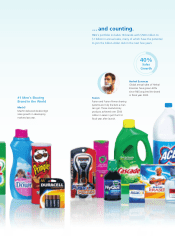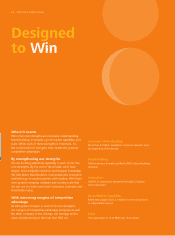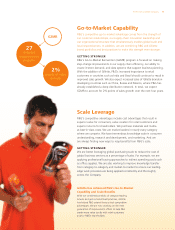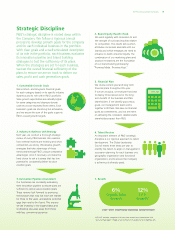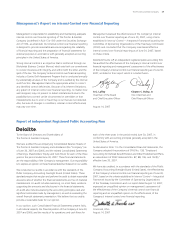Proctor and Gamble 2007 Annual Report Download - page 21
Download and view the complete annual report
Please find page 21 of the 2007 Proctor and Gamble annual report below. You can navigate through the pages in the report by either clicking on the pages listed below, or by using the keyword search tool below to find specific information within the annual report.
P&G’s strategic discipline is rooted deep within
the Company. We follow a rigorous annual
process to develop growth goals for the company
and for each individual business in the portfolio.
With clear goals and a well-articulated description
of its role in the portfolio, each business evaluates
its innovation pipeline and brand building
strategies to test the sufciency of its plans.
When the strategies are set for each business,
we test the overall nancial sufciency of the
plans to ensure we are on track to deliver our
sales, prot and cash generation goals.
We set short- and long-term nancial goals
for each category based on its specic industry
dynamics and its role within P&G’s portfolio.
Sales growth expectations are naturally higher
for some categories and disproportionate
cash returns are expected from others. Each
business’s goals are stretching but achievable,
and we ensure the sum of the goals supports
P&G’s overall growth targets.
We work regularly with consumers to test
the strength of our brand equities relative
to competition. The results tell us which
attributes consumers associate with our
brands and which messages we need to
enhance to build consumer loyalty. The
combination of our marketing plans and
product innovations are the foundation
of our brand-building philosophy:
“Promises Made. Promises Kept.”
&
Each year, we conduct a thorough strategic
review of every P&G business. We examine
how external markets are evolving and what
competitors are doing. We develop growth
strategies that take advantage of these
trends and leverage P&G’s unique competitive
advantages. And, if necessary, we make the
hard choice to exit a business that has low
potential to consistently deliver its value
creation goals.
We review current-year and long-term
nancial plans throughout the year.
If we see a surplus, we evaluate how best
to deploy those resources for the long-
term benet of the business and P&G
shareholders. If we identify gaps versus
goals, our management team works
together to ll them. We view our nancial
goals as commitments, and we are intent
on delivering the consistent, reliable results
shareholders expect from P&G.
Our businesses are constantly evaluating
their innovation pipeline to ensure plans are
sufcient to deliver value-creation goals.
These reviews look forward to promising
technologies that may not reach the market
for three to ve years, and explore potential
gaps that need to be closed. This ensures
we are investing in the biggest ideas and
re-directing resources away from those
with less commercial potential.
An important element of P&G’s strategic
discipline is our rigorous approach to talent
development. The Global Leadership
Council meets three times per year to
identify top talent, to align on management
succession planning for each business unit,
geographic organization and functional
organization, and to ensure the Company
is achieving its diversity goals.
* 2001 EPS excludes a negative $0.61 per share impact from Organization 2005
restructuring program charges and amortization of goodwill and intangible assets.
The Procter & Gamble Company 19





